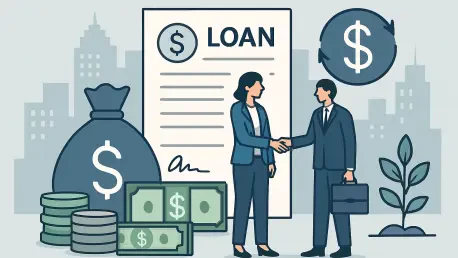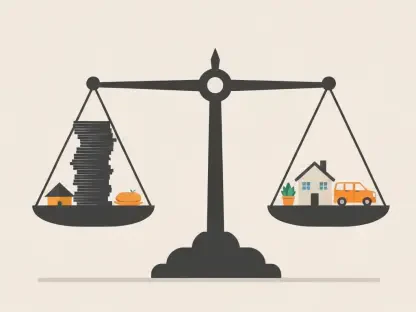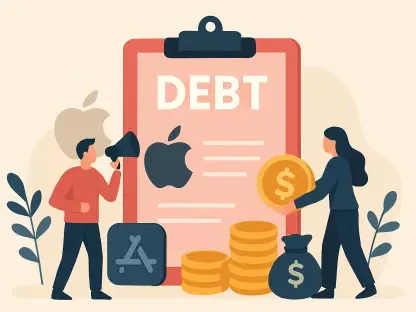What happens when businesses are desperate for capital to grow, but the very institutions meant to fuel their ambitions slam the door shut? Picture a bustling industrial hub where mid-sized firms are ready to expand, only to find their loan applications mired in red tape. This scenario is unfolding across the U.S. as a surge in demand for business loans clashes with banks’ stubborn caution. The tension between eager borrowers and hesitant lenders is creating a bottleneck that could stall economic momentum at a critical juncture.
The stakes of this lending standoff are monumental. With the economy showing tentative signs of recovery after years of uncertainty, access to credit is more vital than ever for job creation and business expansion. Recent data from the Federal Reserve reveals a striking disparity: while mid-sized and large firms are driving the strongest loan demand in recent memory, small businesses remain sidelined, and banks are tightening their grip on credit. This dynamic raises a pivotal question about whether financial institutions are inadvertently choking the lifeblood of economic growth.
A Rising Tide of Demand Meets a Wall of Resistance
The appetite for business loans among mid-sized and large U.S. firms has hit a remarkable peak, marking a significant upswing as reported in the Federal Reserve’s latest quarterly survey for the third quarter. These companies, often the backbone of industrial and technological innovation, are signaling renewed confidence in the economy, eager to invest in new projects and workforce expansion. This surge suggests a belief that the worst of recent economic turbulence may be behind them.
Yet, this enthusiasm is not universal across the business spectrum. Small firms, which form the majority of enterprises in the country, show no notable increase in borrowing interest compared to the previous quarter. Many of these smaller players continue to grapple with lingering uncertainties, lacking the resources or creditworthiness to make a compelling case to lenders. This divide highlights a fragmented recovery where only certain segments of the market feel ready to push forward.
Compounding the issue, banks remain steadfast in their reluctance to loosen credit standards, despite the clear demand from larger firms. Even with a slight easing of restrictions compared to earlier quarters, the financial sector’s risk-averse posture is evident. Lenders appear to prioritize stability over growth, creating a barrier that could dampen the economic potential of this heightened demand.
The Critical Role of Business Lending in Today’s Economy
Access to credit serves as the cornerstone of economic vitality, enabling businesses to scale operations, hire new talent, and drive innovation. In the current climate, with the Federal Reserve implementing a notable 50-basis-point rate cut over recent months to spur activity, the importance of robust lending practices cannot be overstated. These monetary policy moves aim to lower borrowing costs, yet their impact hinges on whether banks pass these benefits on to businesses.
The disparity in loan demand across firm sizes paints a troubling picture of uneven recovery. Mid-sized and large enterprises are showing optimism, perhaps buoyed by stabilizing trade policies, while small businesses remain stagnant, possibly deterred by tougher credit terms or ongoing market challenges. This imbalance risks widening the gap between thriving corporations and struggling smaller entities, potentially undermining broader economic stability.
For policymakers and business leaders, the current lending environment is a call to action. If banks continue to hold back, the ripple effects could stifle job growth and slow the momentum of recovery. The health of the U.S. economy depends on bridging this divide, ensuring that credit flows freely to all corners of the business landscape, not just the most established players.
Unpacking the Lending Landscape: Trends and Tensions
A deep dive into the Federal Reserve’s Senior Loan Officer Opinion Survey reveals a complex web of trends shaping the business loan market. Demand from mid-sized and large firms has spiked to levels not seen in recent years, reflecting growing confidence in economic conditions. This uptick is a promising sign that key sectors are ready to invest and expand, potentially driving significant growth.
Contrastingly, small businesses remain on the sidelines, with loan demand showing little to no change. This stagnation suggests deeper structural issues, such as limited access to favorable terms or persistent economic headwinds affecting smaller operations. The survey also notes that banks are maintaining tightened credit standards across all firm sizes, though the severity has lessened slightly, indicating a cautious approach that may still hinder overall credit availability.
Another layer of complexity emerges in banks’ selective lending practices. Financial institutions show a preference for approving loans to firms with minimal exposure to trade disruptions, while those tied to volatile tariff policies face steeper challenges. This risk-based filtering underscores a broader hesitancy in the financial sector, where protecting balance sheets often takes precedence over fueling business aspirations.
Expert Perspectives on a Tightening Credit Crunch
Insights from industry experts shed light on the growing disconnect between robust loan demand and restrictive lending behaviors. Oren Klachkin, a Financial Market Economist at Nationwide, has voiced concerns that “tighter credit standards risk undermining the stimulative effects of the Fed’s recent rate cuts, leaving many businesses caught in a financial bind.” His analysis points to a potential mismatch between monetary policy goals and on-the-ground realities faced by borrowers.
Adding to the uncertainty, internal debates within the Federal Reserve reveal differing views on the path forward. Some policymakers question the necessity of additional rate cuts in the near term, citing concerns over inflation and labor market conditions. This lack of consensus at the top levels of economic governance further complicates the outlook for businesses seeking affordable credit, as future policy moves remain unclear.
The survey also highlights banks’ wariness toward firms with high trade exposure, a stance shaped by lingering policy uncertainties despite recent trade truces with major partners. This selective caution reflects a financial ecosystem struggling to balance the imperatives of growth with the need for stability, leaving many businesses navigating an unpredictable lending terrain.
Strategies for Businesses to Overcome Lending Barriers
In the face of a constrained credit environment, businesses must adopt proactive measures to secure the capital needed for growth. One effective approach is to prioritize financial transparency by preparing detailed records and realistic growth projections. This can help mitigate perceived risks, particularly for small firms struggling to stand out in a competitive lending market.
Diversifying funding sources offers another viable path forward. Exploring options beyond traditional banks, such as private lenders, venture capital, or government-backed programs, can provide alternatives for firms facing rejection. This strategy is especially critical for businesses with significant trade exposure, which banks currently view as higher-risk propositions.
Staying attuned to policy developments is equally important, as recent trade agreements may create safer borrowing conditions for certain industries. Businesses should position themselves within sectors deemed low-risk by lenders, while also building strong relationships with financial institutions. Engaging with banks early to understand evolving credit criteria can make a crucial difference in securing approval amidst tightened standards.
Reflecting on a Pivotal Moment for Business Lending
Looking back, the clash between rising loan demand and banks’ cautious stance defined a critical chapter in the U.S. economic story. The stark contrast between the optimism of mid-sized and large firms and the stagnation among smaller enterprises painted a picture of uneven recovery. Banks’ tightened credit terms, even as the Federal Reserve sought to stimulate growth through rate cuts, underscored a persistent tension in the financial landscape.
Trade policy shifts also played a dual role in this narrative, initially sowing uncertainty that dampened borrowing interest, then later fostering fragile stability through tentative agreements. Yet, the selective nature of lending approvals—favoring firms with low trade exposure—revealed how deeply risk aversion shaped lender behavior. This period highlighted the complex interplay of economic policy, financial caution, and business needs.
Moving forward, actionable steps emerged as essential for navigating this challenging terrain. Businesses were encouraged to enhance transparency, seek diverse funding, and align with favorable policy trends to secure capital. Policymakers and financial leaders faced the task of ensuring credit access became a bridge rather than a barrier to growth. The lessons from this moment pointed toward a need for collaboration to unlock the full potential of an economy poised for recovery.









